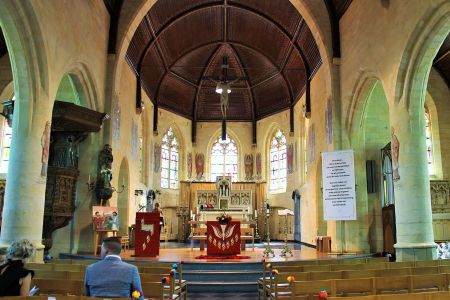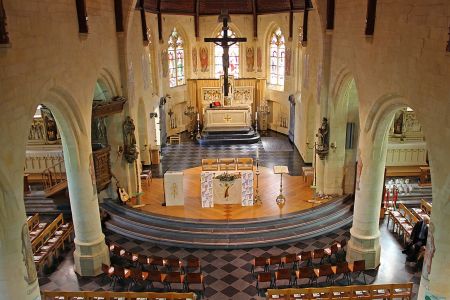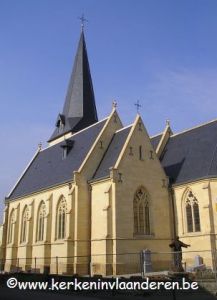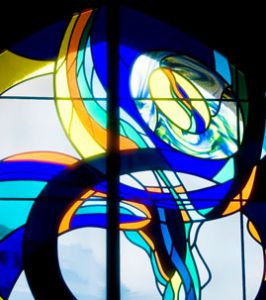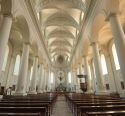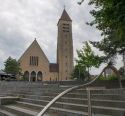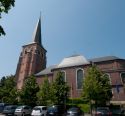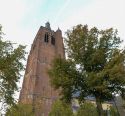Church | 1889-1890 | Romanesque, Gothic, Neogothic | Catholic Church





Map
Opening hours
01 April - 31 October
Mon 9.00 - 18.00
Tue 9.00 - 18.00
Wed 9.00 - 18.00
Thu 9.00 - 18.00
Fri 9.00 - 18.00
Sat 9.00 - 18.00
Sun 9.00 - 18.00
01 November - 31 March
Mon 9.00 - 17.00
Tue 9.00 - 17.00
Wed 9.00 - 17.00
Thu 9.00 - 17.00
Fri 9.00 - 17.00
Sat 9.00 - 17.00
Sun 9.00 - 17.00
Religious offices
Description
For each part of the build, a different material was used. The base of the tower was erected out of brown iron sandstone from the local quarries. The foundation consists of iron ore (chunks of raw material used in the production of iron) which came from the village of Bolderberg and the domain of Terlamen. For the superstructure and the more recent parts of the church, a marlstone coming from the city of Maastricht was used. One then switched to brick as a material for the further extension of the church in 1890.
The oldest parts of the interior are the sedes sapientiae from 1225 and a late Gothic baptismal font from 1550. Furthermore, there stands a baroque pulpit from 1691, that originally came from from the Augustinian convent from the city of Hasselt, a late Gothic statue of Philomena (17th century), a statue of Hubert from the first half of the 18th century, a statue of Saint Vincent and Saint Cornelius from that same time period. The communion rails are in rococo style, and the head altar is in neo-Gothic style. A Jesus on the cross is dedicated to Anthony van Dyck.
KIKIRPA : photo-library online
Photos
Remarkable elements
Sedes Sapientiae
Beautiful early Gothic statue from the 13th century (approx. 1225). In 1893, the statue was professionally polychromed in neo-Gothic style.
Mary, Mother of God, is presented here as “The Seat of Wisdom”. Mary sits on a simple throne chair. She wears a golden crown, and in her right hand she carries a scepter crowned with a lily (a symbol of purity). With her foot, she crushes the head of the dragon (a symbol of evil).
The child Jesus sits on her left knee, and is carrying a globe in his left hand while he is making a blessed gesture with his right hand. The couch was renewed during the restoration of the statue that took place in 1893.
Canvas ‘Our Lady of the Rosary’ (1729)
Painted by B. Willebors in memory of Johanna de Malsen tot Kessenich, spouse of count Ferdinand von Inhausen und Kniphausen, Lord of Castle Vogelsanck (1616-1699).
Centrally depicted stands Our Lady of the Rosary. In the 15 lockets, one can see depicted the virtues and the sorrows of Mary.
On the canvas, Mary presents a rosary to Saint Dominic and the Holy Catherine of Siena. Underneath in both corners, one can see four figures each depicted in fiery purgatory. They refer to the fact that they have to pray to Our Lady of the Rosary to redeem their souls.
Pulpit
1699. The pulpit originally came from the Augustinian convent situated in the city of Hasselt. It is a prime example of baroque wood carving. The staircase was added at a later date.
Head altar
Neo-Gothic stone reredos from 1893 with images of scenes from the Old and the New Testament :
- to the left: Joshua and Caleb are bringing the miraculous cluster of grapes from the promised land, and a depiction of Jesus and The road to Emmaus.
- at the centre : the crucifixion on Calvary.
- to the right : Abraham wants to murder his son Isaac to please God, and a depiction of Moses who is making water flood out of a rock by knocking on it three times.
Murals on on the pillars and the choir
The murals in the church and the choir are actually paintings on canvas that were glued to the walls afterwards. The murals date back from 1893. On the first pillar to your left, one can see the image of patron saint Saint-Vincent. On the first pillar to your right, one can see the name of another patron saint by the name of Saint-Hubert., although according to experts this would have been a depiction of Saint Servatius.
Baptismal font
In 1599, the baptismal font was made out of Namur limestone and made into a holy water font. The pedestal carries the family crest of Geerard Vanderstappen, abbot of Saint Lawrence abbey situated in Liège (1520-1558), who originally came from the village of Zolder and donated this artwork to the church of his birth town. The lid made out of yellow brass is that of the earlier baptismal font, that one strangely enough can find in the city of Liège.
Stained-glass windows
The neo-Gothic stained glass windows were donated to the church in 1893 by baron Jules de Villenfagne de Vogelsanck and his Irish spouse Lady Camilla Preston of the Lords Gormanstone. The stained-glass windows were removed and safely stored when the church closed down in 1980 due to mine subsidence.
They represent the patron saints of the members of the dynasty de Villenfagne. In principle, these images of the saints should correlate to the patron saints of the persons that gave rise to the coats of arms underneath. However, this was not done correctly.



